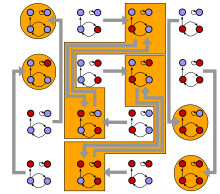
Back الشبكة المنطقية Arabic Boolesches Netzwerk German Red booleana Spanish شبکه بولی Persian Rete booleana Italian
| Part of a series on | ||||
| Network science | ||||
|---|---|---|---|---|
| Network types | ||||
| Graphs | ||||
|
||||
| Models | ||||
|
||||
| ||||

A Boolean network consists of a discrete set of boolean variables each of which has a Boolean function (possibly different for each variable) assigned to it which takes inputs from a subset of those variables and output that determines the state of the variable it is assigned to. This set of functions in effect determines a topology (connectivity) on the set of variables, which then become nodes in a network. Usually, the dynamics of the system is taken as a discrete time series where the state of the entire network at time t+1 is determined by evaluating each variable's function on the state of the network at time t. This may be done synchronously or asynchronously.[1]
Boolean networks have been used in biology to model regulatory networks. Although Boolean networks are a crude simplification of genetic reality where genes are not simple binary switches, there are several cases where they correctly convey the correct pattern of expressed and suppressed genes.[2][3] The seemingly mathematical easy (synchronous) model was only fully understood in the mid 2000s.[4]
- ^ Naldi, A.; Monteiro, P. T.; Mussel, C.; Kestler, H. A.; Thieffry, D.; Xenarios, I.; Saez-Rodriguez, J.; Helikar, T.; Chaouiya, C. (25 January 2015). "Cooperative development of logical modelling standards and tools with CoLoMoTo". Bioinformatics. 31 (7): 1154–1159. doi:10.1093/bioinformatics/btv013. PMID 25619997.
- ^ Albert, Réka; Othmer, Hans G (July 2003). "The topology of the regulatory interactions predicts the expression pattern of the segment polarity genes in Drosophila melanogaster". Journal of Theoretical Biology. 223 (1): 1–18. arXiv:q-bio/0311019. Bibcode:2003JThBi.223....1A. CiteSeerX 10.1.1.13.3370. doi:10.1016/S0022-5193(03)00035-3. PMC 6388622. PMID 12782112.
- ^ Li, J.; Bench, A. J.; Vassiliou, G. S.; Fourouclas, N.; Ferguson-Smith, A. C.; Green, A. R. (30 April 2004). "Imprinting of the human L3MBTL gene, a polycomb family member located in a region of chromosome 20 deleted in human myeloid malignancies". Proceedings of the National Academy of Sciences. 101 (19): 7341–7346. Bibcode:2004PNAS..101.7341L. doi:10.1073/pnas.0308195101. PMC 409920. PMID 15123827.
- ^ Drossel, Barbara (December 2009). "Random Boolean Networks". In Schuster, Heinz Georg (ed.). Chapter 3. Random Boolean Networks. Reviews of Nonlinear Dynamics and Complexity. Wiley. pp. 69–110. arXiv:0706.3351. doi:10.1002/9783527626359.ch3. ISBN 9783527626359. S2CID 119300231.
© MMXXIII Rich X Search. We shall prevail. All rights reserved. Rich X Search
